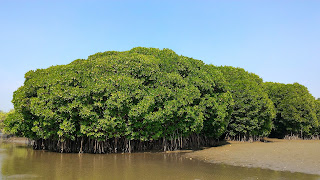KADALUNDI MANGROVE FOREST

Kadalundi - Vallikkunnu Community Reserve spread across the 1.5km2 , endowed with good patches of Mangrove forest . Phytosociology is a scientific discipline which encompasses the study of plant community , composition , diversity and relationships among the component species . The present study aim on floristic diversity and structural dynamics of mangroves in Kadalundi - Vallikkunnu Community Reserve situated in Calicut - Malappuram districts of kerala .



A total of 7 species belonging to 5 families were enumerated . The study area shows a dominance of Avicennia officinalis followed by Rhizophora mucronata , Excoecaria agallocha whereas Sonneratia alba recorded lowest density . Maximum Relative Basal area was represented by Avicennia officinnalis followed by Rhizophora mucronata therefore these species registered the highest Important Value Index ( IVI ) and Relative IVI among the 7 mangrove species . Diversity indices was found out for entire study area with Shannon Weiner index of 2.117, Equitability of 0.745 and Simpson's diversity index of 0.713 respectively . Since many of the anthropogenic activities going on this community Reserve , unique composition of this mangrove forest has to be protected in its natural condition




Mangrove Biodiversity

Because mangrove occupy the intertidal zone , they interact strongly with aquatic , inshore , upstream and terrestrial ecosystem and in this way mangrove help to support a diverse flora and fauna of marine , freshwater and terrestrial species .


It is essential to regard biological diversity at three levels; genetic , species and ecosystem,
The genetic diversity in mangroves is almost known as . The movement of mangrove plant genetic material for reforestation purposes , or other uses, must be controlled and recorded more carefully than at present . Genetic material should come from local sources wherever possible , using good quality mangrove forest stand as the source of the material..


mangrove species diversity is well known for the larger animals and plants , but poorly known for micro - organisms and insects , A crucial aspect of biodiversity for mangrove management is that many species use the mangrove forest ecosystem only part of the time ( Eg ; fish , birds , crustaceans , shellfish ) , Thus , the mangrove habitat supports many more species as visitors , or indirectly , and these support functions must be taken into account as part of conservation management ...



The many unique species of mangrove animals and plants and their morphological and physiological specialisations to the diverse and dynamic habitat characteristics of mangroves make them extremely valuable for further research into biological adaptation. A number of mangrove plant and animal groups also provide valuable subjects for evolutionary studies ........
welcome to kadalundi ....
THANK YOU........



